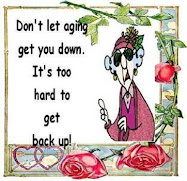God love her,
I surely do
Senior Patriot Moment
Here's a quote from a government employee who witnessed a recent inter-action between an elderly woman and an antiwar protester in a Metro station in DC.
There were protesters on the train platform handing out pamphlets, on the evils of America . I politely declined to take one..
The elderly woman was behind me getting off the escalator and a young (20-ish) female protester offered her a pamphlet, which she politely declined.
The young protester put her hand on the old woman's shoulder as a gesture of friendship and in a very soft voice the young lady said, "Lady, don't you care about the children of Iraq ?"
The old woman looked up at her and said, "Honey, my father died in France during World War II, I lost my husband in Korea , and a son in Vietnam.
All three died so you could have the right to stand here and badmouth our country.
If you touch me again, I'll stick this umbrella up your ass and open it."
~God Bless America ~
From my mountain top to yours...Please take the time to always says a prayer for our service men and women...who give us our FREEDOM each and every day...
Until next time, Hugs and smiles Gl♥ria
 J- LO and Mark Anthony's home.....
J- LO and Mark Anthony's home.....  Oprah's
Oprah's Halle Berry
Halle Berry John Travolta This I love...how cool to have your own landing strip and Jets right at your front door....
John Travolta This I love...how cool to have your own landing strip and Jets right at your front door....  Tiger Woods.....Serves him right
Tiger Woods.....Serves him right Tiger Woods 155 foot Yacht Named "PRIVACY" Maybe he should have paid more attention into that name in his real private life ha ha!!
Tiger Woods 155 foot Yacht Named "PRIVACY" Maybe he should have paid more attention into that name in his real private life ha ha!! The Yacht Tiger Woods wanted...
The Yacht Tiger Woods wanted... The Yacht he's going to own after the divorce....
The Yacht he's going to own after the divorce.... Well guys I hope I gave you all a little giggles today.... Due to some personal health issues I'm been having I won't be blogging for awhile....I want to THANK all of you that have taken the time to come by and visit with me...It's truly has been a real blessing to me each day to get up and turn on my computer to see I have MAIL....I really have enjoyed getting to meet all the Wonderful caring and sharing People I have met in Bloggerville....I hope to be back real soon....But until then always try each and every day to live your life to the fullest, take the time to reach out each day and say a kind word to someone...you just don't know but maybe just that one act of kindness will be what that person needs that day....
Well guys I hope I gave you all a little giggles today.... Due to some personal health issues I'm been having I won't be blogging for awhile....I want to THANK all of you that have taken the time to come by and visit with me...It's truly has been a real blessing to me each day to get up and turn on my computer to see I have MAIL....I really have enjoyed getting to meet all the Wonderful caring and sharing People I have met in Bloggerville....I hope to be back real soon....But until then always try each and every day to live your life to the fullest, take the time to reach out each day and say a kind word to someone...you just don't know but maybe just that one act of kindness will be what that person needs that day....








































































